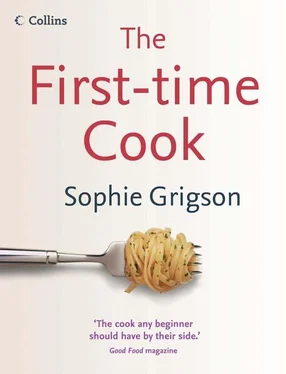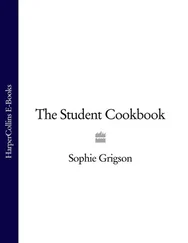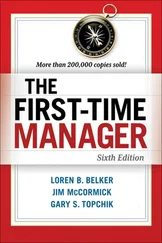Slice off the base and the tip of the clove (photo 2). If you are going to chop or crush the garlic, the easiest way to get the skin off is to place the clove flat on the chopping board, then press the bowl of a wooden spoon down on it firmly, crushing it gently (photo 3). Now the skin will almost fall off.
If, on the other hand, you intend to slice the clove, or keep it whole, pull the skin away bit by bit with your fingers. Any skin that sticks can be loosened by running the blade of the knife, held at an angle to the clove, firmly down the skin.
Garlic is chopped in much the same way as onion, but scaled down appropriately. If you’ve crushed it virtually flat when removing the skin, then you obviously won’t be able to slice it horizontally.
A garlic crusher is quick but wasteful. A lot of good garlic gets left behind or stuck in the holes. A knife does the job more efficiently, though it takes a little practice.
Peel the garlic and chop it very roughly into three or four pieces. Sprinkle with a good pinch of salt (this diminishes slippage). Press the flat of the blade of the knife down on the pieces, crushing them, then drag the sharp end of the blade, at an angle to the board, over the smashed pieces. Push them all back together, and repeat the dragging and crushing until you have a smooth paste. The dismaying thing is how little you end up with, but don’t fear – the impact of the smoothly crushed garlic will be epic.
Pile the leaves up together on the chopping board. Grab the biggest knife you own (but not a serrated knife). Hold the handle with your right hand, and the tip with your left (reverse this if you are left-handed). Hold the knife over the herbs, the tip in contact with the board close to one side of the heap. Now hold the tip steady on the board, and bring the knife firmly and quickly down on the herbs, again and again, swinging it backwards and forwards. Push the herbs back together in a pile, and repeat the whole operation. Keep doing this until the herbs are chopped as you want them. With practice this becomes an easy, quick and rhythmic operation.
This is also the method to use for fine chopping garlic or onion, once they have been roughly chopped in the usual way.
Cut a small cross in each tomato, opposite the stalk end (photo 1). Place in a bowl and cover with boiling water (photo 2). Leave for a minute, then pick the tomatoes out of the water. The skin will now pull away from the tomato with ease (photo 3). If it doesn’t, repeat the process – the tomatoes must have been under-ripe.
Method 1For tomatoes that are to be cooked in a sauce or stew or soup. Halve the tomatoes through the equator, i.e. cutting halfway between stalk end and base (photo 1). Squeeze each half over a bowl or bin, just as if you were squeezing out lemon juice (photo 2). The seeds will ooze out.
Method 2For when you want perfect looking pieces of tomato. Halve the tomatoes as for method 1, then scoop out the seeds with a teaspoon (photo 3).
Begin by slicing off the stem end as if it were a lid. Turn the pepper upside down and tap the base firmly several times to loosen the seeds. Shake them out, and scrape out any malingerers with a knife. When you want to keep the pepper whole, perhaps for stuffing, or cut it into rings, you should also scrape out the white ribs (not 100% necessary, but it does improve the flavour a mite). For quartered peppers or long strips, cut the cup into four from one corner to the other, to give flattish pieces. This makes them easier to cut into strips, or grill. Remove the odd seed and cut away the white ribs if you haven’t already. Now cut into strips if required.
It is the capsaicin in chillies that makes them hot. When you handle chillies, capsaicin transfers itself to your fingers, so you need to be extremely careful that you don’t rub your eyes, or worse still, especially for men, go to the loo, before cleaning your hands thoroughly. The results can be painful. Capsaicin is not water-soluble, so you need to use a good deal of soap, or some alcohol-based cleanser to get rid of it all. Either that or wear rubber gloves when working with chillies, not a bad idea if you have sensitive skin. The plus side of this is that you absolutely need to drink some kind of alcohol with a hot curry, if you want to soothe your mouth and throat. Water just won’t do.
Halve the chillies lengthways and scrape out the seeds and cores with a knife. These are the hottest parts, although the flesh too is hot (as described above).
Chillies vary in heat, and there seems to be a correlation between size and heat – often the smallest chillies are the hottest!
Topping and Tailing Beans
Most fresh green beans need to be topped and tailed. This means cutting off the tips on both ends. I like to do them individually, as long as there is something interesting to listen to on the radio. When I have a huge pile to work through, I’m inclined to become more wasteful – taking a bunch of beans at a time, lining up the ends and then just slicing them all off in one fell swoop.
The zest of all citrus fruit contains aromatic oil, and this adds wonderful flavour to many dishes, along with the juice. Rub the surface of the (washed) fruit to and fro on the fine grid of a flat grater several times to remove the zest without any of the bitter white pith. Move around the fruit, covering different areas, until it is denuded. Only then squeeze the juice!
Recommended Kitchen Utensils
It is impossible to make one definitive list of the essential cooking implements and utensils you will need. Absolute basics are fairly obvious – with nothing but one sharp knife and a frying pan or saucepan, you could turn out a fair number of severely streamlined meals. After that, the list is dictated as much by what you like to cook as anything else.
View your ‘batterie de cuisine’ (cooking equipment) as a long-term collection that you will build up over the years. Sadly, the general rule is that the more you spend, the better the quality, and better quality often makes for easier, more enjoyable cooking. So, no long list but instead a few notes and recommendations on useful kitchen kit, and recommended buys.
CasseroleEvery home should have one (unless, of course, you loathe stews of any sort). Best bet is a flame- and heatproof casserole that can go both on the hob and in the oven. It should also look good enough to go straight from the oven to the table. It is better to buy a larger casserole dish than a smaller one, allowing plenty of room. After all, most stews improve in flavour if kept for a day or two in the fridge, or can be frozen if necessary, so making a big potful is a pretty sensible thing to do, even if you are just cooking for one or two.
Chopping BoardsHard to do without, so again, buy the best and biggest you can afford. It is far more useful to have one really big wooden chopping board, than several small book-sized ones. Chopping boards should be made of wood (which scientists now consider perfectly hygienic as long as you wash them after use) or plastic.
Food ProcessorYou can manage very well without one, but your kitchen life will become a good deal easier with. Here, as so often, you should probably head for the best you can afford. Choose one with a relatively large capacity, and several different speed settings. Several models have small inner bowls that can be fitted to process small amounts – very useful for making curry pastes and spice rubs, amongst other things.
Читать дальше












